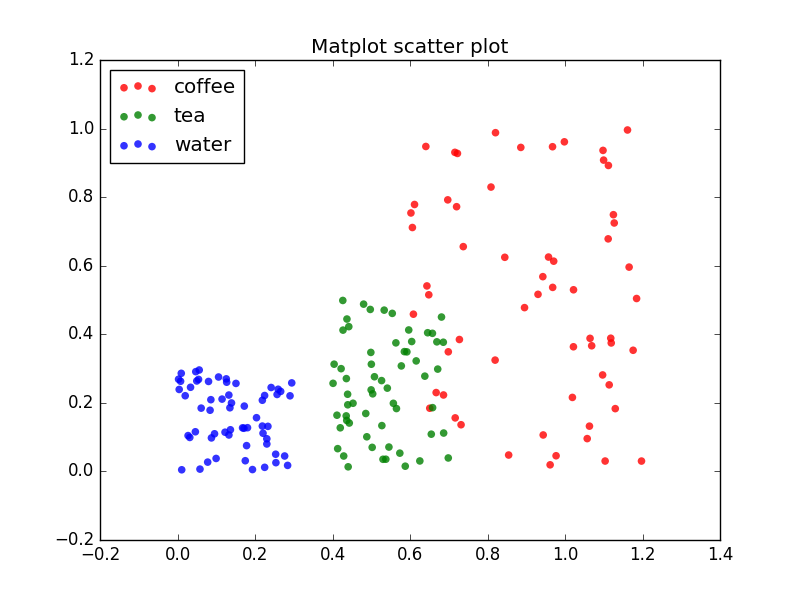

- #MAKE A SCATTER PLOT PYTHON FOR FREE#
- #MAKE A SCATTER PLOT PYTHON HOW TO#
- #MAKE A SCATTER PLOT PYTHON CODE#
More specifically, over the span of 11 chapters this book covers 9 Python libraries: Pandas, Matplotlib, Seaborn, Bokeh, Altair, Plotly, GGPlot, GeoPandas, and VisPy.
#MAKE A SCATTER PLOT PYTHON HOW TO#
It serves as an in-depth, guide that'll teach you everything you need to know about Pandas and Matplotlib, including how to construct plot types that aren't built into the library itself.ĭata Visualization in Python, a book for beginner to intermediate Python developers, guides you through simple data manipulation with Pandas, cover core plotting libraries like Matplotlib and Seaborn, and show you how to take advantage of declarative and experimental libraries like Altair. ✅ Updated with bonus resources and guidesĭata Visualization in Python with Matplotlib and Pandas is a book designed to take absolute beginners to Pandas and Matplotlib, with basic Python knowledge, and allow them to build a strong foundation for advanced work with theses libraries - from simple plots to animated 3D plots with interactive buttons.
#MAKE A SCATTER PLOT PYTHON FOR FREE#
✅ Updated regularly for free (latest update in April 2021) Let's start off by plotting the generosity score against the GDP per capita: import matplotlib.pyplot as pltĪx.scatter(x = df, y = df) Change Marker Size in Matplotlib Scatter Plot

Then, we can easily manipulate the size of the markers used to represent entries in this dataset. We'll use the World Happiness dataset, and compare the Happiness Score against varying features to see what influences perceived happiness in the world: import pandas as pdĭf = pd.read_csv( 'worldHappiness2019.csv')

In this tutorial, we'll take a look at how to change the marker size in a Matplotlib scatter plot. Much of Matplotlib's popularity comes from its customization options - you can tweak just about any element from its hierarchy of objects. Img = img.reshape(_width_height() + (3,))įor x, y, c in zip(,, ):įig = plt.figure(figsize=figsize, dpi=dpi, tight_layout=".Matplotlib is one of the most widely used data visualization libraries in Python. Img = np.frombuffer(_rgb(), dtype=np.uint8) import numpy as npįrom _agg import FigureCanvasAgg as FigureCanvas Note this solution forfeits access to the original fig object and attributes, so any other modifications to figure should be made before it's drawn. I opted to instead plot each layer separately with alpha=1 and then read in the resulting image with np.frombuffer (as described here), then add the alpha to the whole image and plot overlays using plt.imshow. I also wanted to plot a different shape other than a circle. import matplotlib.pyplot as plt import pandas as pd df pd.readcsv ( 'worldHappiness2019.csv' ) fig, ax plt.subplots (figsize ( 10, 6 )) ax.scatter (x df 'GDP per capita', y df 'Generosity', s df 'Score' 25 ) plt.xlabel ( 'GDP per Capita' ) plt.ylabel ( 'Generosity Score' ) plt. I had to plot >500000 points, and the shapely solution does not scale well. Here's a hack if you have more than just a few points to plot. That means that the separation needs to be chosen based on the range of your data, and if you plan to make an interactive plot then there's a risk of all the data points suddenly vanishing if you zoom out too much, and stretching if you zoom in too much.Īs you can see, I found 1e-5 to be a good separation for data with a range of. If they're two far apart then the separation will be visible on your plot, but if they're too close together, matplotlib doesn't plot the line at all. One caveat is that you have to be careful with the spacing between the two points you use to make each circle. Plt.rcParams = 'round'Īx.plot(*expand(x1, y1), lw=20, color="blue", alpha=0.5)Īx.plot(*expand(x2, y2), lw=20, color="red", alpha=0.5)Īnd each color will overlap with the other color but not with itself. With that in mind, you can do this: import numpy as np You see while Matplotlib plots data points as separate objects that can overlap, it plots the line between them as a single object - even if that line is broken into several pieces by NaNs in the data. This is a terrible, terrible hack, but it works. Polygon2 = ptc.Polygon(np.array(polygon2.exterior), facecolor="blue", lw=0, alpha=alpha) Polygon1 = ptc.Polygon(np.array(polygon1.exterior), facecolor="red", lw=0, alpha=alpha) Polygons2 =, y2).buffer(size) for i in range(n)]Īx = fig.add_subplot(111, title="Test scatter") Polygons1 =, y1).buffer(size) for i in range(n)]
#MAKE A SCATTER PLOT PYTHON CODE#
Here is the code : import matplotlib.pyplot as plt You can get this scatterplot with Shapely.


 0 kommentar(er)
0 kommentar(er)
